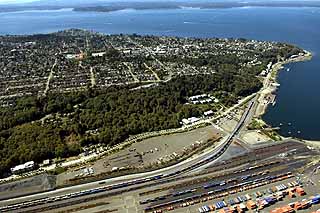
Port of Seattle
Management: Joe McWilliams, managing director, real estate division
Headquarters: Seattle
Current projects: 42-mile-long Eastside rail corridor the port is buying from BNSF Railway; 10-acre CEM site near Jack Block Park in West Seattle which may become an industrial office park, parking lot or soccer field

Photo by Don Wilson/Port of Seattle
The Port of Seattle is looking at turning a 10-acre West Seattle site, pictured between the railroad tracks and trees, into an industrial park, parking lot or soccer field.
|
Financial uncertainty has not bypassed the Port of Seattle. A few months ago, the port was predicting it would issue an RFP for the 57 acres of available land at North Bay by early 2009, but that RFP is on hold for now. And plans for an 89-acre business park in Des Moines have been cancelled, much to the distress of that city, which was counting on $10 million a year in revenue.
“It was going to be a big employment base,” said Joe McWilliams, the new manager of the port’s real estate division.
The Des Moines Creek business park was to include a big-box store, but those stores weren’t interested. So Majestic Realty, the Southern California developer who was going to build the business park, cancelled its plans for now.
“They have said they would still be interested when market conditions change,” McWilliams wrote in an e-mail.
That land in Des Moines has been vacant since the early 1990s, when the port purchased it from individual homeowners in preparation for building the third runway.
Until the bond markets calm down, the port won’t be buying the 42-mile BNSF rail corridor, either. But it is still making plans for hiring a freight operator for the northern segment of the line and for managing the 800 easements on the corridor.
“Some of the records are so old it’s a challenge to grant new easements,” McWilliams said.
Introspection
With these projects on hold, it’s a good time for self-examination, and the port has been doing a lot of that lately as part of its 25-year plan called Century Agenda.
McWilliams has met with stakeholders in real estate, local government, labor, manufacturing and land-use law to brainstorm how the port should handle its properties in the long term. Some of the questions they are asking: What role should the port be playing in public and private real estate development? How should the port determine the rates it charges for its various properties?
“Do we invest in real estate or do we invest in job creation?” McWilliams said.
Current issues with the port’s Maritime Industrial Center, located on the Ship Canal near Fishermen’s Terminal, are a perfect illustration of this dilemma, McWilliams said.
The MIC offers dock space to repair and moor boats, but the big boats are having a hard time docking there because of sediment buildup. It will cost the port $3 million to dredge the berth.
“Can we justify making a $3 million investment when the vessel earns us $146,000 a year?” McWilliams asked.